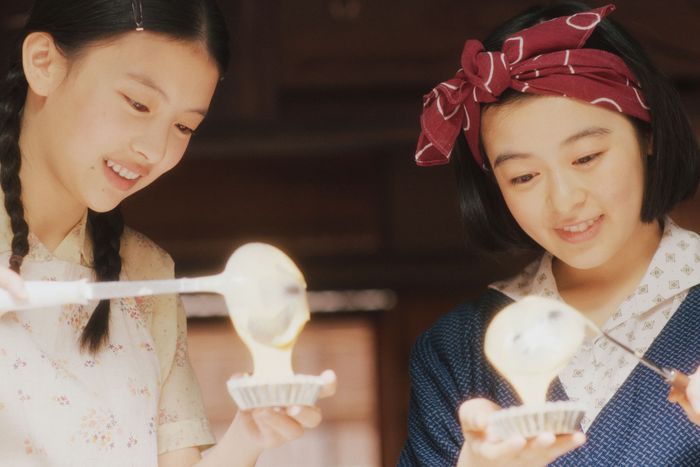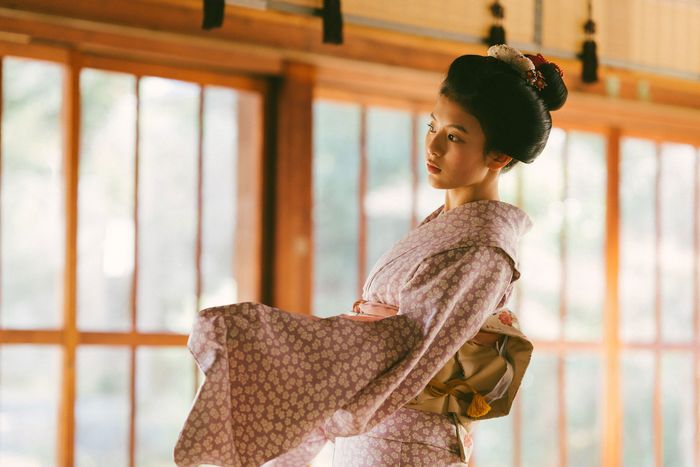
Spoilers follow for The Makanai: Cooking for the Maiko House.
Each of the credits sequences that open The Makanai: Cooking for the Maiko House’s nine episodes ends with an invitation to indulge. A bowl of chicken, noodles, and silky egg sauce promises warmth and comfort in “Guardian Spirit.” An individually sized bread pudding with a drizzle of deep caramel sauce in “Taboo” offers extravagance. Slices of eggplant, deeply scored and stewed in a rich broth, evoke memories of childhood, protection, and home in “Wish.” Hirokazu Kore-eda’s new live-action adaptation of the popular manga series Kiyo in Kyoto: From the Maiko House (which also received an anime adaptation in 2021) is set in the all-female Saku House, which accommodates apprentice maiko as they train to be geiko (geishas), and the house’s makanai, or cook, prepares meals so that the students can focus on their craft. Diners often use the word “nostalgia” to describe the meals served in The Makanai, and the dishes that revolve through the series’ first few minutes — humble, steaming, and freshly prepared — suggest a show that occupies itself only with cozy nourishment.
But that cottagecore-by-way-of-Studio Ghibli aesthetic — with its close-ups of chopped vegetables and boiling pots, subplots about holiday celebrations and a city-spanning journey to find the best dashi ingredients, and long takes of the poised geiko performing traditional, steeped-in-meaning mai dances — belies a surprisingly feminist depiction of fulfillment through ambition rather than romance. Over the course of the season, now streaming in full on Netflix, the maiko, geiko, and other women affiliated with the Saku House get caught up in school crushes, long-simmering flirtations, stolen looks, and admissions of unrequited love. Yet The Makanai always returns to the suggestion that a woman chase her own goals and intentions instead of a man’s, and it does so with gentle persistence.
Over bowls of udon soup, platters of fried tempura, and stacks of bread crusts fried and tossed in sugar, Saku House’s generations of women reveal their histories and their plans, but never tumble into regret: A teenage girl defies her father’s wish to become a doctor, and instead leaves home to study as a maiko; one of the Saku House mothers reunites with a long-ago flame, but isn’t remorseful that they never got together or raised a family; an established geiko turns down a marriage proposal from a man she cares for deeply because he assumed she would leave her job behind. “Doesn’t food taste the best when you share it?” protagonist Kiyo (Nana Mori) asks one of her housemates, and the appetites satiated in The Makanai are both material and metaphysical.
The series follows 16-year-old teenage best friends Kiyo and Sumire (Natsuki Deguchi), who are moving together from their snowy, pastoral home in Aomori to cultural capital Kyoto. On a school field trip, the pair fell for the tranquil atmosphere of the geiko district and vowed that instead of going to high school, they would relocate to Kyoto to study as makai. From the very first scene, The Makanai links their devotion to each other, and their future plans, with their shared memories of food: As Kiyo’s grandmother (Kayoko Shiraishi) serves them nabekko dumplings in red bean soup, the young women don’t converse around the table, but simply reflect each other’s expressions of delight at each bite of this good-luck meal. Later, on the train to Kyoto, as Kiyo shares with Sumire the baked sweet potato their close friend Kenta (Kairi Jyo) gave them as a snack for the journey, the girls fall into the same grateful giggles and appreciative silence. Showrunner Kore-eda’s previous film work has recurrently focused on both biological and found families (Still Walking, Our Little Sister, and After the Storm; Shoplifters and Broker) and The Makanai straddles that same line. Every character introduced in Aomori calls Kiyo’s grandmother “Grandma,” as if her role is collective rather than individual; in Saku House, Sumire and Kiyo are instructed to call the older trainee maiko and professional geiko “sister” and their house guardians “mother,” fostering an immediate sense of camaraderie. From Kiyo’s family home to her and Sumire’s new one, the lines of authority are matriarchal.
When Mother Chiyo (Keiko Matsuzaka) and Mother Azusa (Takako Tokiwa) welcome Sumire and Kiyo to Saku House, they remind the young women of the cultural practices they will need to perfect and perform during their training: respect toward one’s elders, repetitive deference and effusive gratitude, precise and formal language and etiquette. Once they graduate to geiko, those manners will be an essential part of their work at privately booked parties, celebrations, and other special events at which they’ll perform mai and entertain guests. It becomes clear quite quickly in premiere episode “Change,” though, that Kiyo is not going to cut it, since her attention is devoted less to her music and dance lessons than to what the house’s makanai is going to cook for each meal. Is it karaage, or fried chicken? Somen or yakisoba noodles? Mori’s line deliveries are so guileless and enthusiastic that she helps maintain The Makanai’s upbeat tone, even in situations where Kiyo’s exuberance may seem out of place: In the middle of a meeting with her mai instructor about how she’ll probably get kicked out of her apprenticeship for not reaching the level of the other students, in particular the exemplary Sumire, Kiyo urges her teacher to eat her udon before it gets soggy. When the Saku House makanai arrives for her shift, Mori’s eager look into the older woman’s grocery bag aligns us with and legitimizes Kiyo’s perspective — isn’t “What are we having for lunch?” a valid question for one’s happiness?
The Makanai’s validation of Kiyo’s culinary passion means that when she’s expelled from the program, it’s not an occasion for shame or humiliation. The promise she made to Sumire about trying her best at Saku House remains in place, but now, Kiyo can flourish on her own terms. Her shift from maiko to makanai is a realignment, not a failure — her implicit interests made explicit — and The Makanai continues finding that balance for other characters in a way that challenges the expected notions of what would make them happy. Each of Kiyo’s recipes allows for another member of Saku House to become sharper and more defined. In “Taboo,” returning geiko Yoshino (Mayu Matsuoka), who left her husband behind to come back to Saku House and work again, sneakily eats one of Kiyo’s pickling umeboshi fruits, an indication of her mischief and tendency toward self-preservation. In “Wish,” Kiyo’s skills add interiority to the house’s mother figures: Her preparation of Kamo eggplant freezes Mother Chiyo in place as she remembers the same flavor from her childhood, and her latte with a four-leaf-clover design in the foam delights Mother Azusa, who demonstrates her own fondness for Kiyo when she asks her former disciple if she’s happy in her new makanai position. This free-flowing dialogue — a fluid exchange of memories, motivations, and aspirations — often takes place at the kitchen table, the location that Kiyo has created as a place of uninhibited honesty and desire.
Kiyo’s certainty serves as an inspiration for other Saku House members to decide what they want for themselves: for Azusa’s daughter Ryoko (Aju Makita), who intends to study abroad after graduating high school so she can find her own path and a friendship as close as Kiyo and Sumire’s, and for maiko Tsurukoma (Momoko Fukuchi), who decides to leave Saku House and the geiko world because she doesn’t love the program as much as either Kiyo does the kitchen or fellow apprentice Sumire does the mai. Just as Kiyo was supported in her new endeavor, so too are Ryoko and Tsurukoma, with the former reassured by Saku House regulars that she’ll one day form a bond so meaningful with someone that they can “communicate without words,” like Kiyo and Sumire do through their memory-laden foods, and the latter receiving a good-luck send-off of nabekko dumplings cooked by Kiyo and Saku House’s other apprentices. The nabekko are a deliberate callback to the ones Kiyo’s grandmother prepared for her and Sumire before their move to Kyoto, and a sign of Kiyo’s strengthened selfhood — her confidence in her skill manifesting as contentment for and celebration of others.
The Makanai makes Kiyo’s zeal for her work not an anomaly, but a natural extension of an environment in which women are encouraged to put effort and creativity into their artistic pursuits. Saku House’s star graduate, Japan’s top geiko Momoko (Ai Hashimoto), kicks against the rule that geiko cannot keep performing after getting married, but shares with her assistant Sumire her realization that “real love isn’t just a romantic feeling. You can fall in love with your art, not just a man.” When Momoko finally meets Kiyo, whom she calls her “rival” for Sumire’s loyalty, she recognizes in Kiyo’s recipe brainstorming the same kind of fortitude that drives her own mai: “You seem like you’re having so much fun.” Whatever competition they might have been in for Sumire’s attention falls to the wayside once Kiyo and Momoko find common ground in their zest for process and their devotion to their tools (the frying pan Kiyo was gifted by her grandmother, the kanzashi hair ornament that Momoko lends to Sumire).
These steps toward convergence take place over meals, of course — bowls of white stew and pork miso soup — and on the night of Sumire’s debut in finale “Passage,” when others are shocked to hear Sumire, decked out in her geiko finery and ready to walk past a crowd of photographers, ask Kiyo what she’ll do with the leftover bread crusts from dinner, Momoko’s fond smile at her former assistant’s curiosity is laced with tender understanding. “Every single one of us gets a choice of our own. We can either cook, or be the one who eats it,” Grandma says to Kenta in “Passage,” but The Makanai doesn’t favor one role over the other. Sumire and Kiyo couldn’t have become the best versions of themselves without the hunger — personal and professional — that brought them together, and The Makanai comes full circle with an ending that makes sure both are fed.
All nine episodes of The Makanai: Cooking for the Maiko House are now streaming on Netflix.



